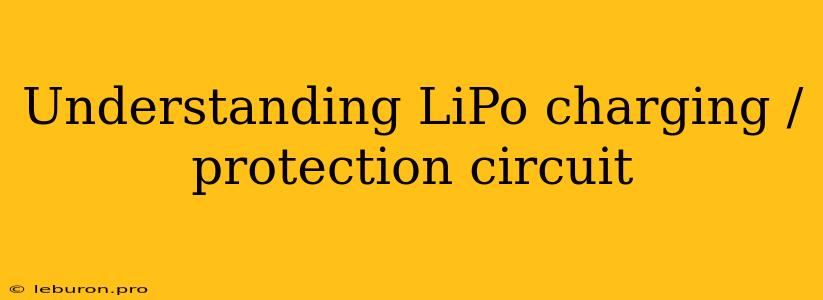Lithium Polymer (LiPo) batteries are a popular choice for powering various devices due to their high energy density and lightweight design. However, these batteries require careful handling and a proper charging/protection circuit to ensure their safety and longevity. Understanding the intricacies of LiPo charging and protection circuits is crucial for anyone using or working with these batteries. This article will delve into the key components and functionalities of these circuits, providing a comprehensive guide to their operation and importance.
Understanding LiPo Charging Circuits:
LiPo batteries are sensitive to overcharging, which can lead to overheating, swelling, and even fire hazards. Therefore, a dedicated charging circuit is essential to regulate the charging process and prevent these risks. The primary components of a LiPo charging circuit are:
1. Constant Current (CC) Stage:
In the initial stage of charging, the circuit delivers a constant current to the battery until it reaches a certain voltage level. This stage rapidly charges the battery while minimizing heat generation.
2. Constant Voltage (CV) Stage:
Once the battery reaches a predetermined voltage, the charging circuit switches to a constant voltage mode. The current gradually decreases as the battery reaches full capacity. This stage ensures that the battery voltage remains stable while maintaining maximum charge.
3. Termination Stage:
When the charging current drops to a predefined threshold, usually a small percentage of the initial charging current, the charging process terminates. This prevents overcharging and ensures that the battery remains at its optimal charge level.
Understanding LiPo Protection Circuits:
LiPo batteries are also vulnerable to over-discharging, short circuits, and over-current conditions. A protection circuit safeguards the battery from these potentially harmful events.
1. Over-Discharge Protection:
The protection circuit monitors the battery voltage and automatically disconnects the load when it drops below a predefined threshold. This prevents irreversible damage to the battery from excessive discharge.
2. Short-Circuit Protection:
If a short circuit occurs between the battery terminals, the protection circuit immediately interrupts the current flow to prevent excessive heat generation and potential fire hazards.
3. Over-Current Protection:
The protection circuit continuously monitors the current flowing through the battery. If the current exceeds a specified limit, the circuit automatically disconnects the load to protect the battery from damage.
Importance of LiPo Charging and Protection Circuits:
The presence of a properly designed and implemented charging/protection circuit is paramount for the safe and efficient operation of LiPo batteries. Here's why:
- Safety: The circuit prevents overcharging, over-discharging, short circuits, and over-currents, reducing the risk of fire, explosion, or battery damage.
- Longevity: By preventing abusive charging and discharge cycles, the circuit extends the battery's lifespan and maintains its performance.
- Reliability: The protection circuit ensures that the battery functions reliably and consistently, even under challenging conditions.
Choosing the Right Charging/Protection Circuit:
Selecting the appropriate charging and protection circuit for a specific LiPo battery is critical. Factors to consider include:
- Battery Capacity: The circuit's current and voltage ratings should match the battery's specifications.
- Charging Rate: The charging rate, expressed in C-rate, determines the charging current and time.
- Protection Features: The protection circuit should offer the necessary features, such as over-discharge, short-circuit, and over-current protection.
Conclusion:
Understanding LiPo charging and protection circuits is essential for ensuring the safety, longevity, and reliability of these popular batteries. Implementing a dedicated charging and protection circuit safeguards the battery from potentially harmful conditions, extending its lifespan and ensuring its optimal performance. By carefully selecting and utilizing the right circuit for your LiPo batteries, you can minimize risks and enjoy the benefits of these powerful energy sources.
